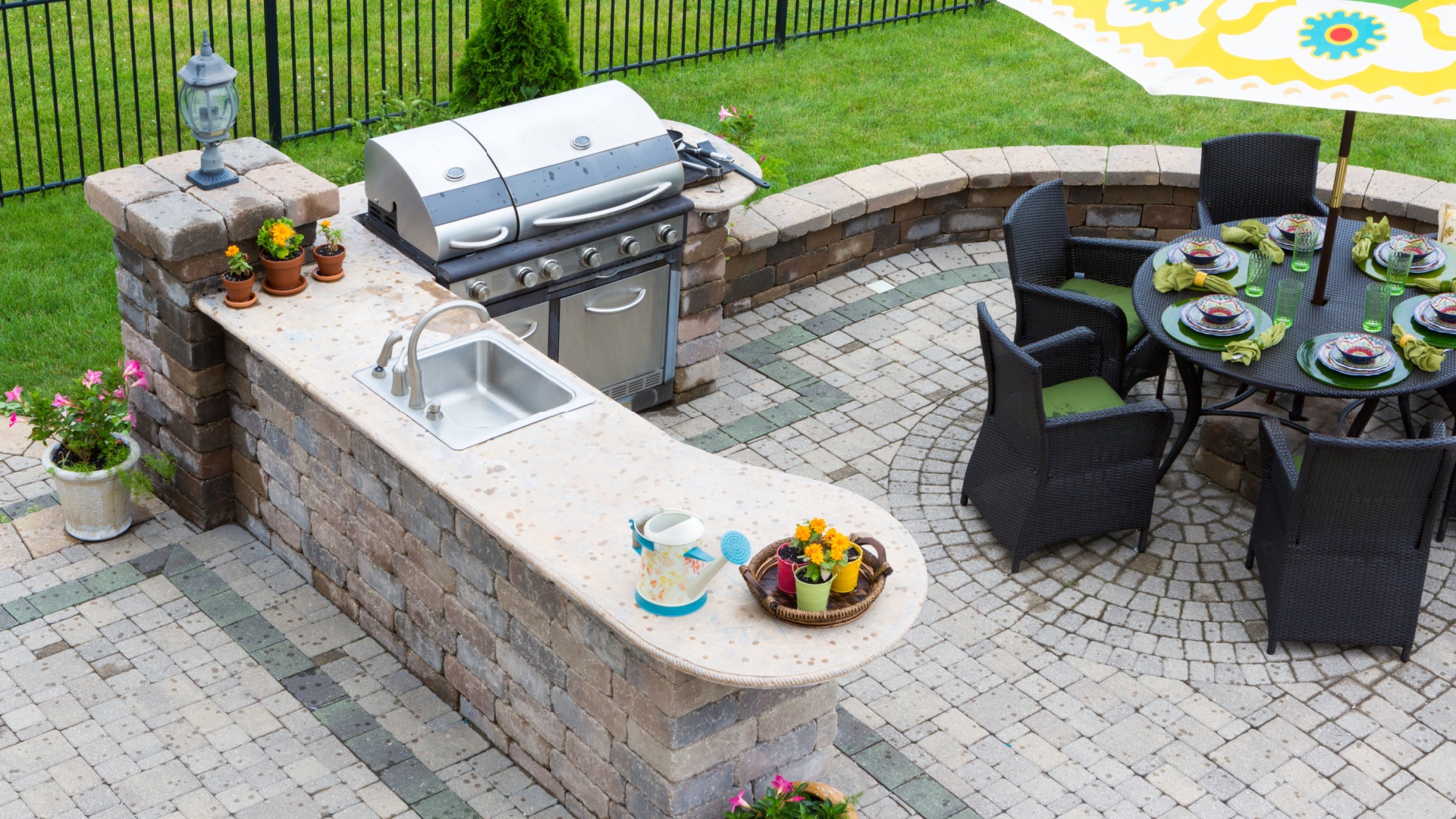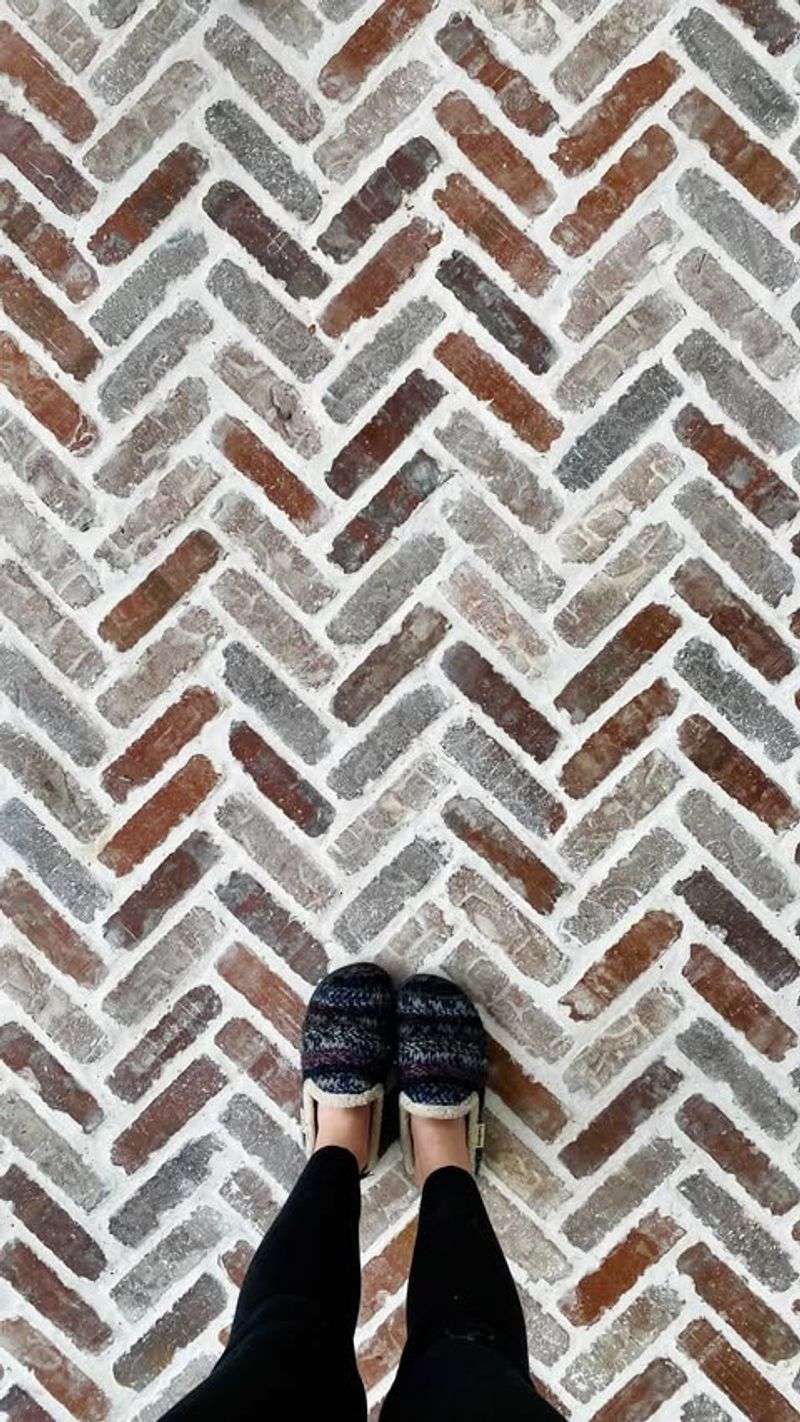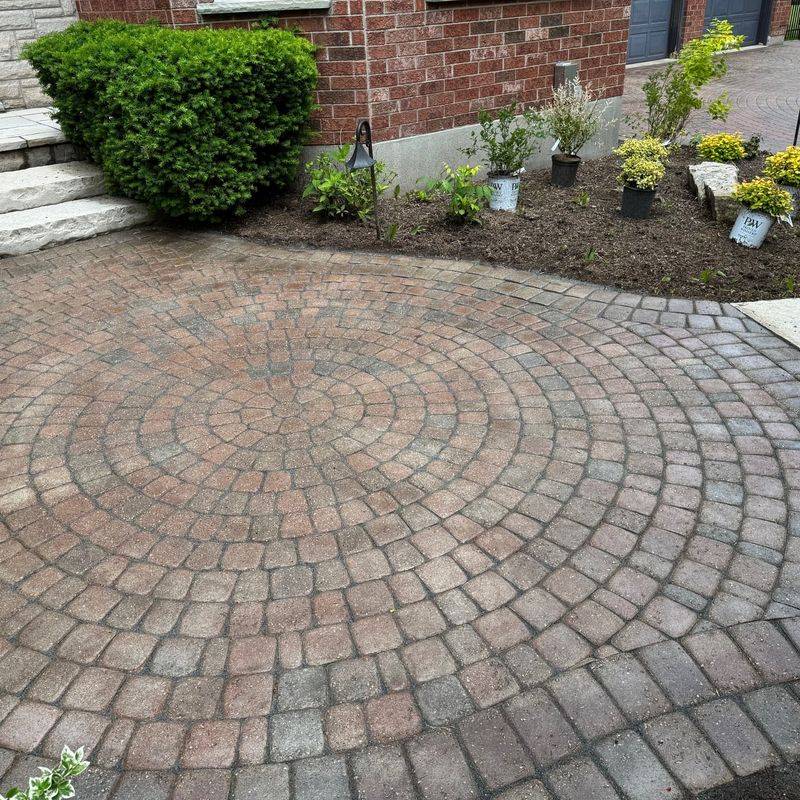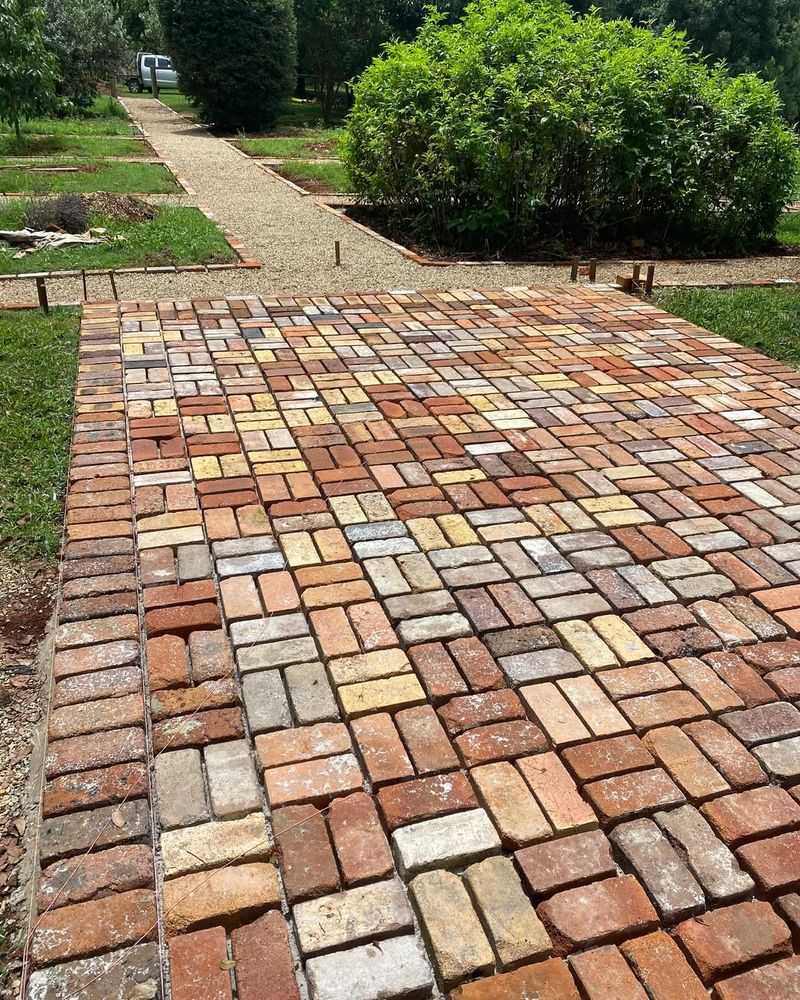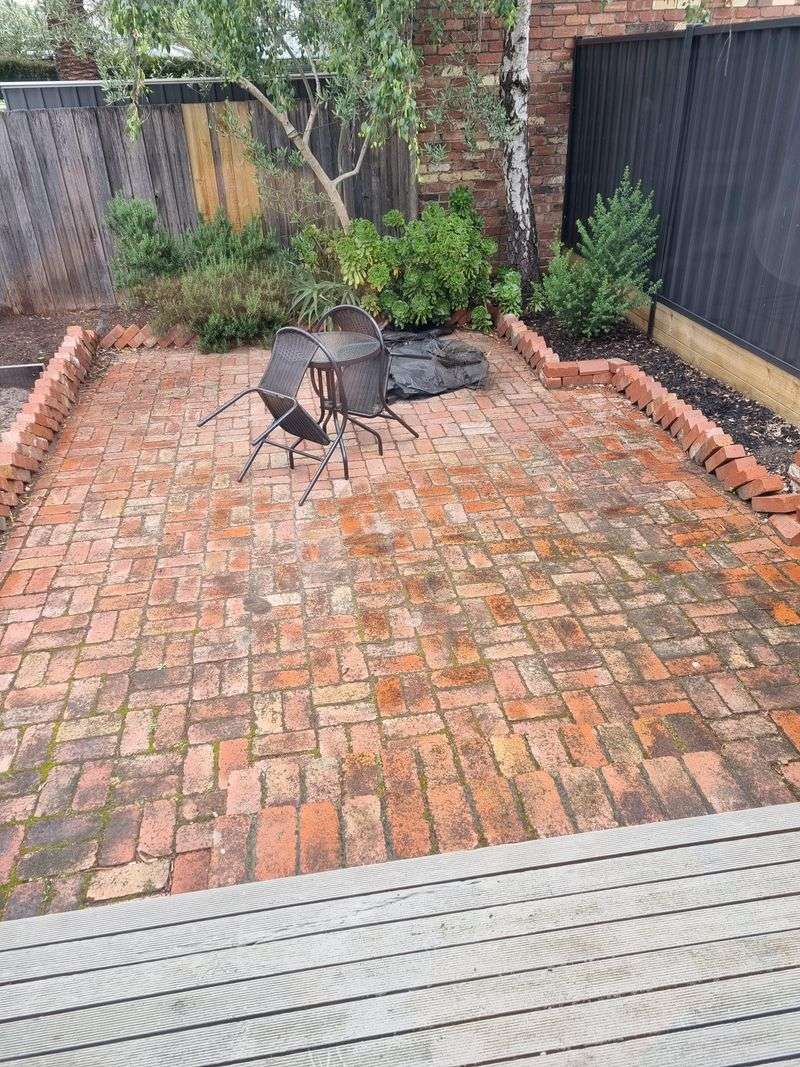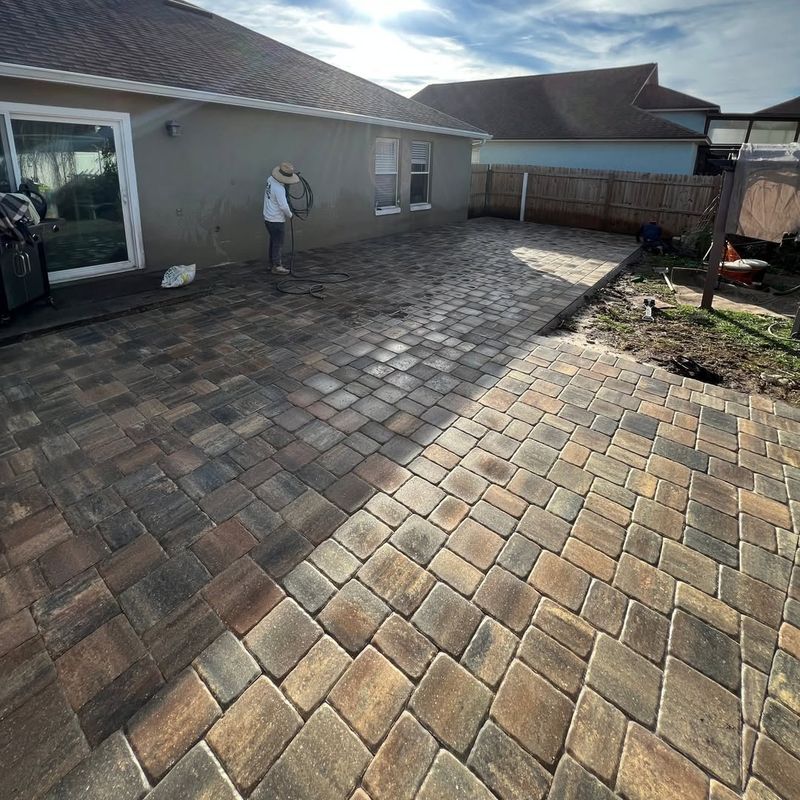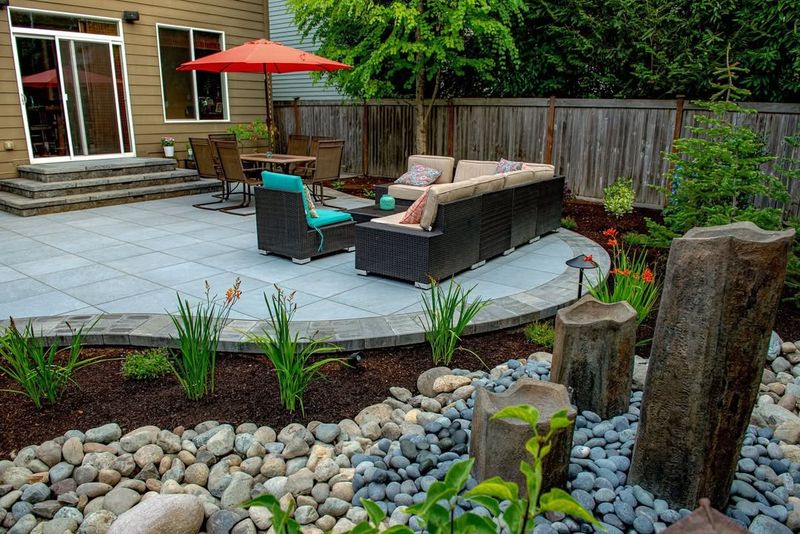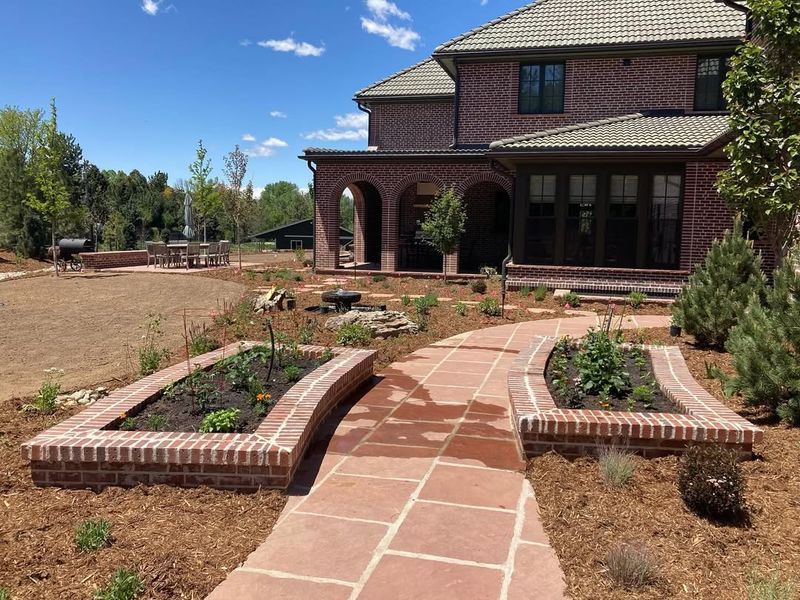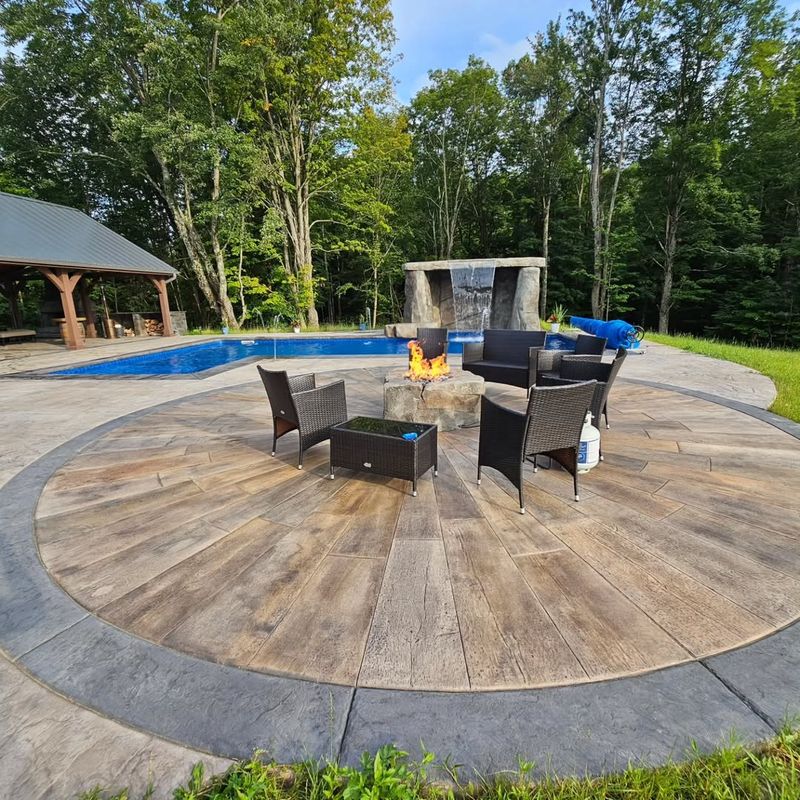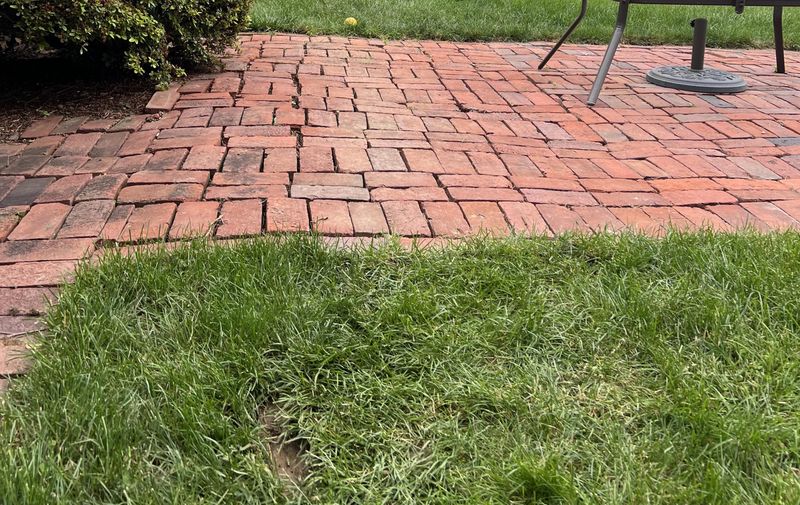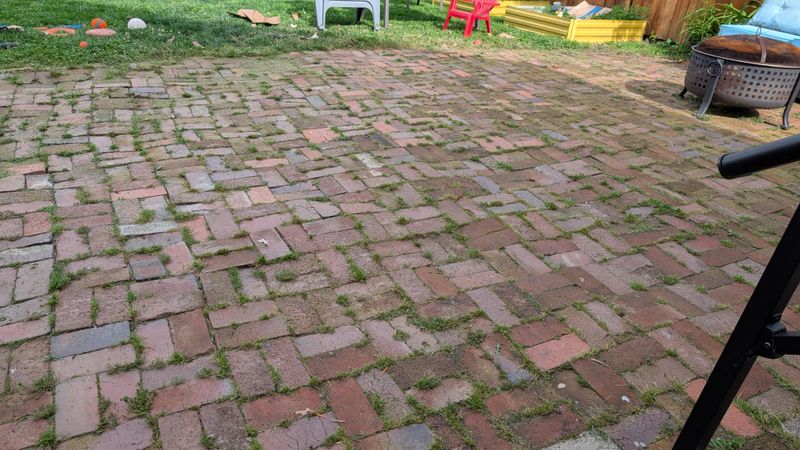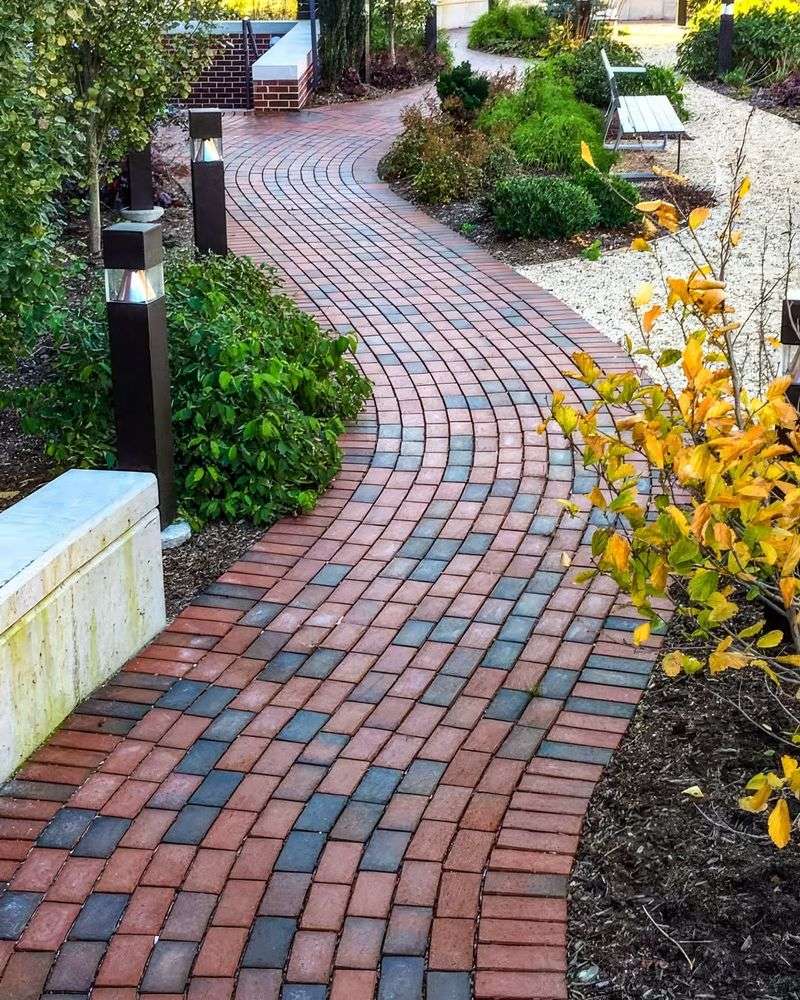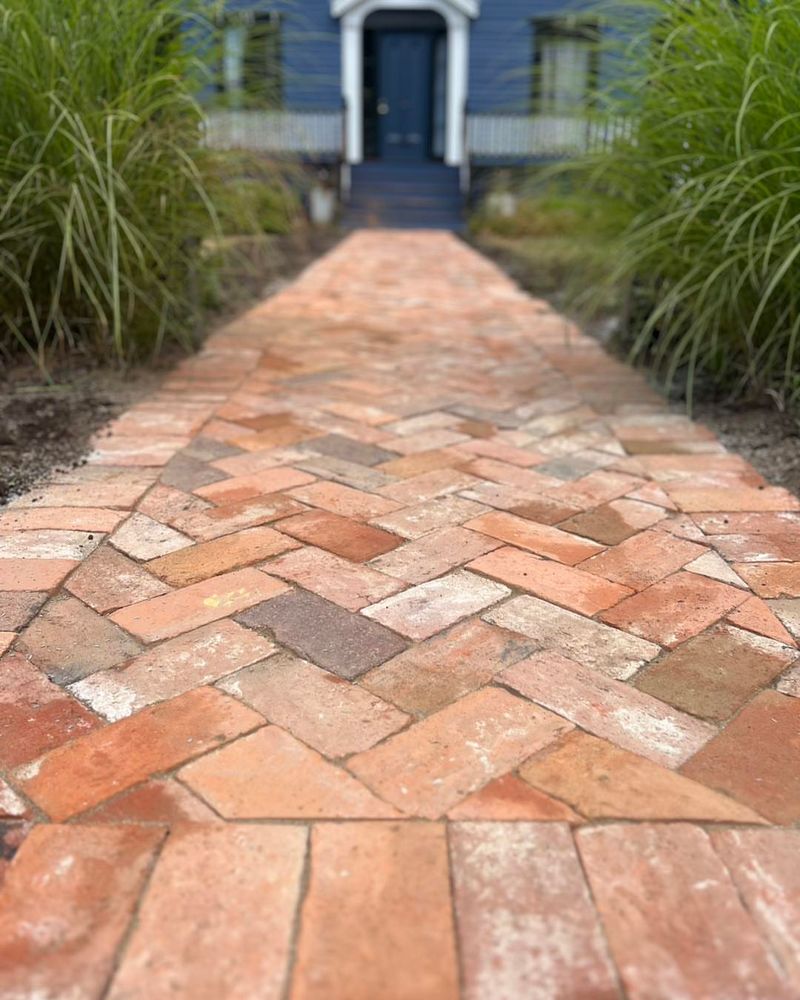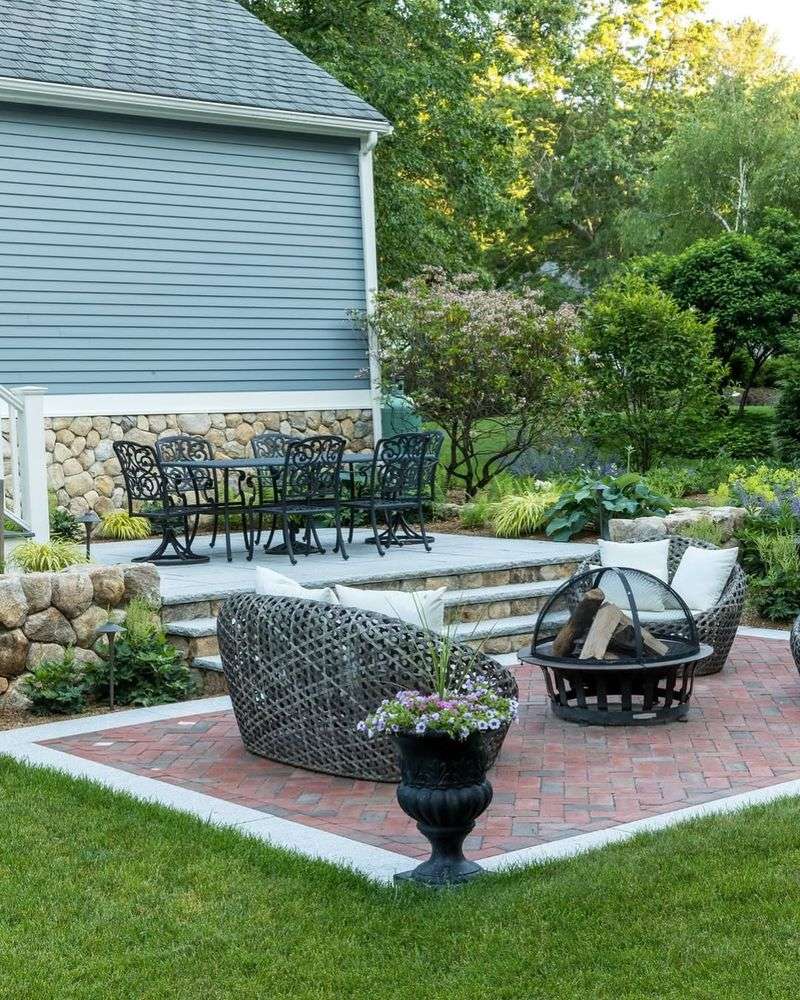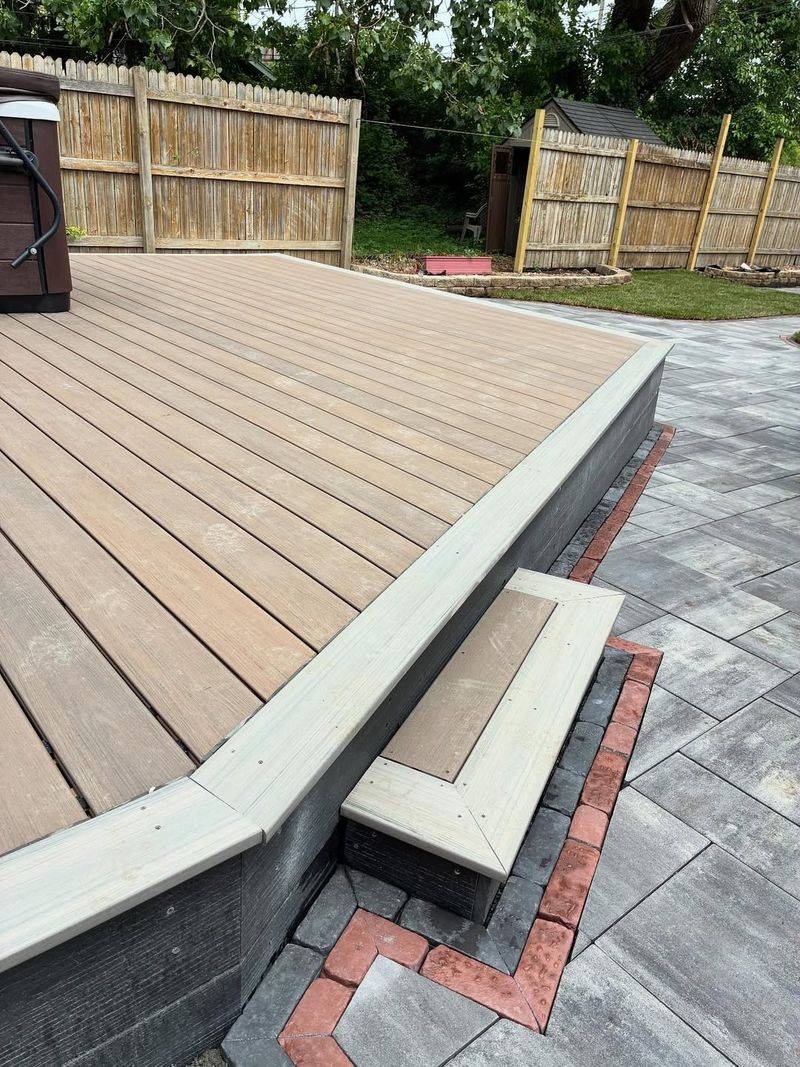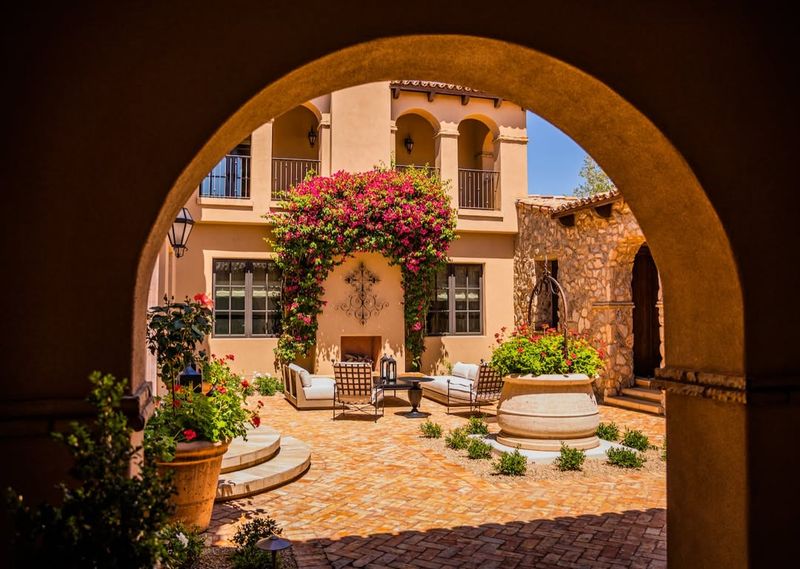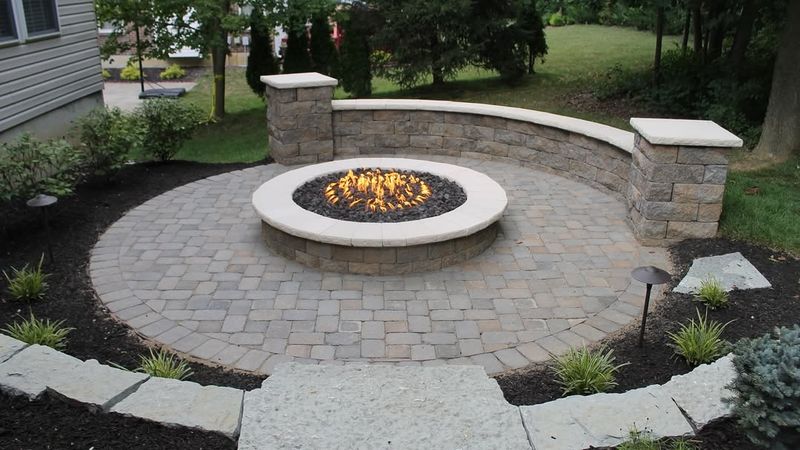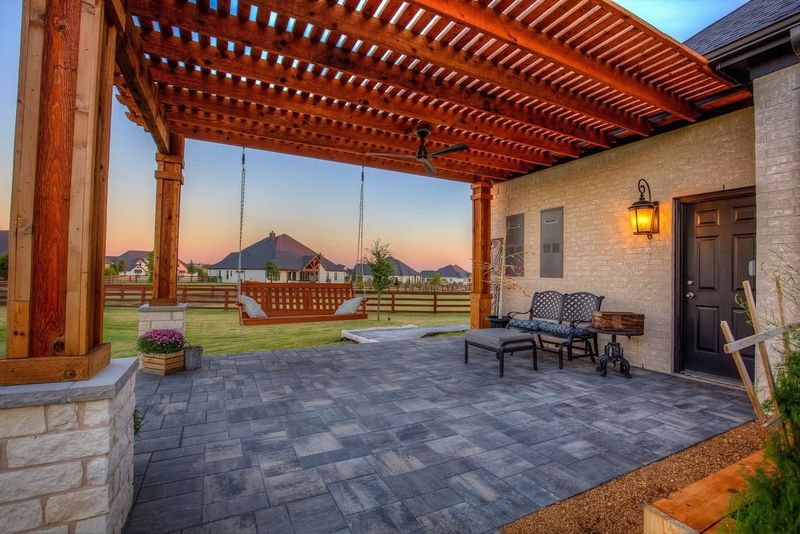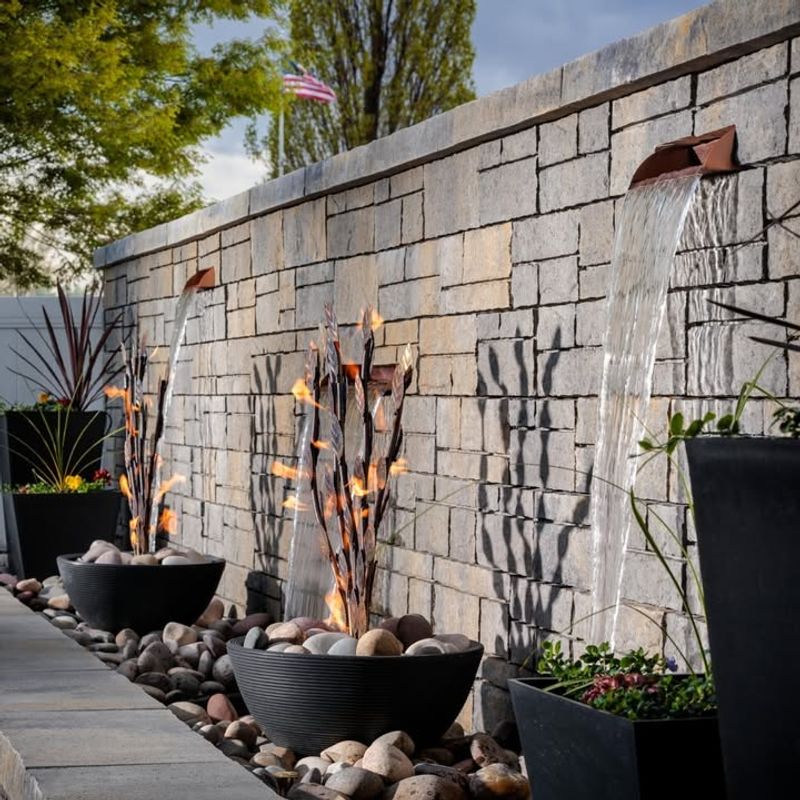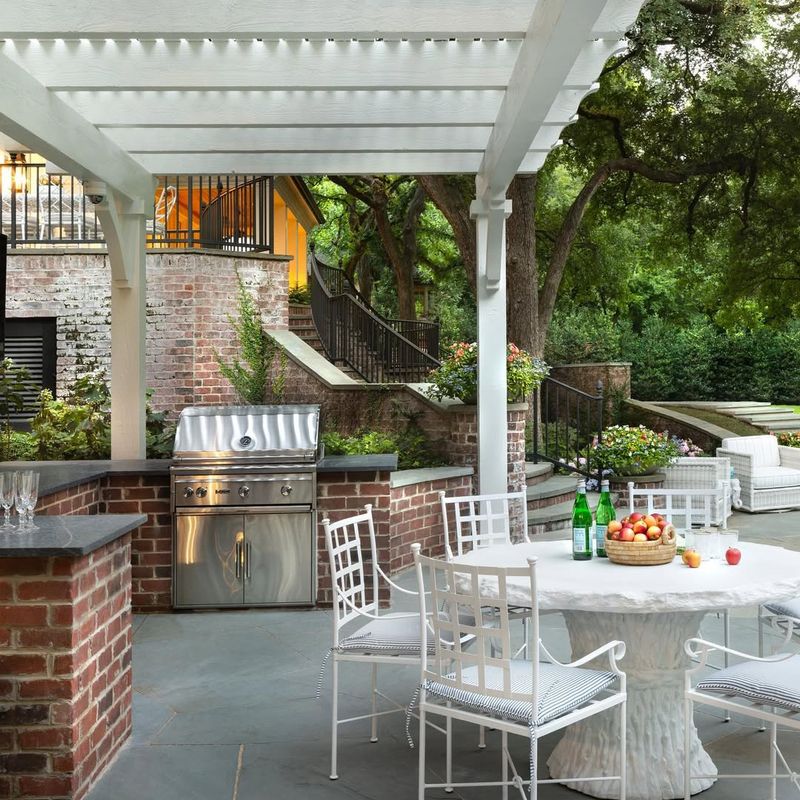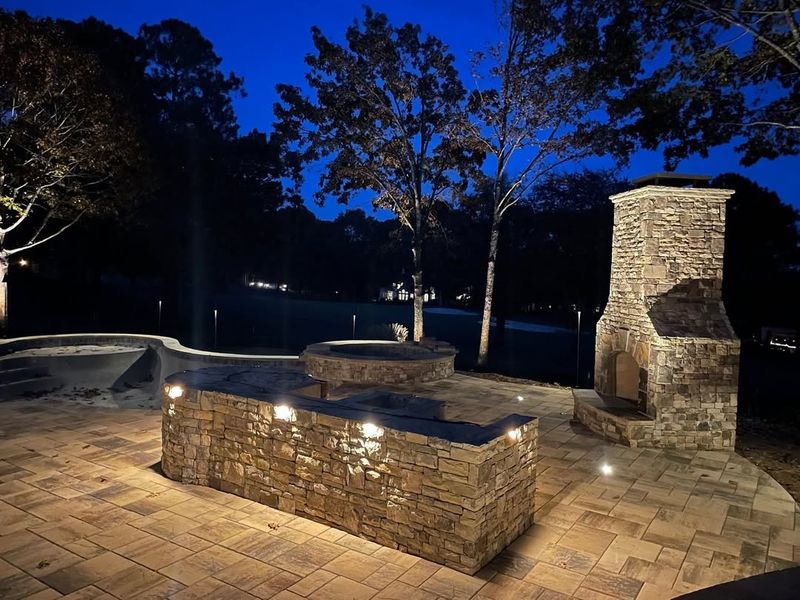I wanted an outdoor space that felt like a getaway—without leaving home. The secret? Brick. These 15 brick patio ideas turned my backyard into a cozy, stylish escape I never want to leave. From classic patterns to unexpected touches, each idea brings charm, function, and serious relaxation vibes.
And just when you think it can’t get better, I’ve added a few more ideas that go the extra mile.
1. Herringbone Pattern Magic
The zigzag arrangement of a herringbone brick pattern creates visual movement that makes even small patios appear larger. Dating back to ancient Roman roads, this classic design adds instant sophistication to any outdoor space.
For best results, choose bricks in complementary tones like terracotta and sand to enhance the pattern’s distinctive angles. The intricate layout requires more cutting than simpler patterns, but the stunning result is worth the extra effort.
2. Circular Brick Paradise
Round patios break away from traditional squares and rectangles, creating a focal point that draws the eye and invites gathering. The curved edges soften the landscape and create a natural flow between different yard areas.
Starting from a center point, bricks radiate outward in concentric circles, often requiring special wedge-shaped pieces for perfect alignment. Add a fire pit or round table at the center to complete this conversation-friendly space that encourages face-to-face interaction.
3. Basket Weave Wonder
Resembling woven fabric, the basket weave pattern alternates pairs of bricks in vertical and horizontal orientations. This creates a textured, dimensional effect that adds character without overwhelming the space.
Popular since the colonial era, basket weave patios pair beautifully with traditional home styles but can also complement modern designs with the right brick color. The alternating orientation provides excellent structural stability, helping your patio remain level even through seasonal ground shifts.
4. Running Bond Simplicity
Sometimes the simplest approach creates the most elegant result. Running bond—where bricks are laid in straight rows with joints staggered like a basic brick wall—offers clean lines that complement any garden style.
The straightforward pattern makes installation faster and requires fewer cut bricks than complex designs. For added interest, consider laying the pattern at a 45-degree angle to your house or garden beds, which creates dynamic diagonal lines that guide movement through your yard.
5. Multi-Colored Brick Mosaic
Playing with different colored bricks can transform a standard patio into a custom work of art. Mix shades of red, tan, gray, and brown to create patterns, borders, or even simple geometric designs within your patio space.
The color variation adds dimension and helps hide stains or discoloration that might develop over time. When selecting multiple colors, stick to the same brick style and size for consistent installation, and arrange a mock layout before permanent placement to ensure you’re happy with the color distribution.
6. Brick and Pebble Combination
Marrying brick with smooth river pebbles creates textural contrast that awakens the senses. The combination works wonderfully for pathway borders, inset designs, or creating distinct zones within a larger patio area.
The rounded pebbles provide excellent drainage in areas prone to puddling. For a cohesive look, choose pebbles that pick up colors found in your brick selection, and secure them with polymeric sand or clear resin to prevent scattering while still allowing water to drain through.
7. Raised Brick Planters
Built-in planters bring greenery directly into your patio design, softening the hardscape with living elements. Brick planters can double as casual seating walls and help define the patio’s boundaries.
Varying the height creates visual interest—try 18 inches for seating areas and 24-30 inches for standing planters. Remember to include drainage holes at the planter base and line with landscape fabric before adding soil to prevent staining from plant nutrients and water runoff.
8. Sunburst Pattern Focal Point
Create a showstopping centerpiece with a sunburst pattern that radiates from a central point. Often used in circular sections or as an accent within larger patios, this dramatic design draws the eye and establishes a natural gathering spot.
While complex to install, the payoff is a truly custom feature that elevates your entire landscape. Professional installation is recommended for this pattern, as precise cutting and placement are crucial for the geometrically perfect lines that make sunburst designs so striking.
9. Permeable Brick Solutions
Environmentally friendly permeable brick patios allow rainwater to seep between specially designed bricks and into the ground below. This reduces runoff, prevents erosion, and helps replenish groundwater supplies.
The system requires a deep base of graduated gravel layers for proper drainage. Many municipalities offer incentives for permeable hardscaping, potentially offsetting the slightly higher installation cost. As a bonus, these patios typically experience less heaving in freeze-thaw cycles.
10. Brick and Grass Checkerboard
Alternating squares of brick with sections of grass creates a playful checkerboard effect that balances hardscape with living greenery. This semi-permeable design allows for drainage while maintaining a structured appearance.
Choose a hardy grass variety like zoysia or bermuda that can withstand foot traffic. For easier maintenance, consider replacing live grass with artificial turf in the open squares. The pattern works especially well for transitional areas between full patios and lawns.
11. Curved Brick Pathways
Gently winding brick paths add movement and mystery to your landscape, guiding visitors through the garden with natural flow. Unlike straight paths that reveal everything at once, curves create a journey of discovery.
Flexible plastic edging helps maintain crisp curves without brick slippage. For a cohesive look, match your pathway bricks to your main patio, but consider laying them in a different pattern to distinguish the walking areas. Soft lighting along curved paths creates magical evening ambiance.
12. Vintage Reclaimed Brick Charm
Salvaged from old buildings, reclaimed bricks bring history and character impossible to replicate with new materials. Their weathered patina, slight irregularities, and occasionally visible maker’s marks tell stories of the past.
Beyond aesthetic appeal, reusing existing materials reduces environmental impact. While typically more expensive than new bricks, reclaimed options often feature denser clay and superior craftsmanship from earlier manufacturing methods. Their varying sizes require more adjustment during installation but result in a uniquely authentic patio.
13. Brick Steps and Terraces
Transform a sloped yard into usable outdoor living space with brick terraces connected by wide steps. Each level creates a distinct activity zone while solving drainage and erosion challenges.
Incorporating the same brick in both horizontal surfaces and risers creates visual continuity. Low walls between levels can double as seating and planter edges. When designing multi-level patios, consider making each terrace at least 8 feet deep to accommodate furniture comfortably.
14. Brick and Wood Deck Combination
Pairing the warmth of wood with the durability of brick creates a multi-textured outdoor space that highlights the best qualities of both materials. Use brick for high-traffic or dining areas where stability matters, and wood for lounging spaces where barefoot comfort is key.
The material transition offers natural opportunities to change levels or define different functional zones. For visual harmony, choose wood stains that complement your brick color palette, and consider using brick as a fireproof base beneath grills or fire features.
15. Mediterranean-Inspired Courtyard
Channel old-world European charm with a brick courtyard that creates an intimate outdoor room. Surround the space with stucco walls, climbing vines, or tall planters to establish a sense of enclosure and privacy.
Terra cotta pots filled with lavender, rosemary, and citrus trees enhance the Mediterranean feel. A central fountain provides gentle background sounds that mask neighborhood noise. For authentic character, choose bricks with warm, sun-baked tones and consider a simple pattern that allows the surrounding elements to shine.
16. Brick Fire Pit Gathering Space
Few outdoor features draw people together like a fire pit. A circular brick design creates a natural focal point that anchors your patio and extends outdoor enjoyment into cooler months.
Arrange comfortable seating about 7-10 feet from the fire’s edge for ideal warmth without overheating. For safety, use firebrick for the interior wall facing the flames, as standard bricks can crack under intense heat. Consider a removable metal fire bowl insert for easier ash cleanup.
17. Brick Patio with Pergola Shade
Combat summer heat by topping your brick patio with a pergola that provides filtered shade while maintaining airflow. The vertical structure creates a sense of outdoor architecture that makes the space feel like a true room.
Train climbing plants like wisteria or grape vines along the pergola for additional shade and seasonal interest. The combination of overhead structure with solid brick flooring creates a balanced outdoor space that feels both protected and open. Add outdoor curtains for privacy and wind protection when needed.
18. Water Feature Integration
The sound of moving water adds a sensory dimension to brick patios that transforms the atmosphere completely. From simple bubbling fountains to elaborate waterfalls, water features create focal points that mask background noise and attract wildlife.
Consider recirculating designs that minimize water usage while maximizing enjoyment. Surrounding the water feature with carefully placed bricks helps contain splashes and provides stable footing. For night enjoyment, underwater lights create magical reflections that dance across the brick surface.
19. Outdoor Brick Kitchen and Dining
Take outdoor entertaining to new heights with a dedicated brick cooking and dining area. A built-in grill station with countertops and storage eliminates constant trips between indoor and outdoor spaces.
Brick’s heat resistance makes it ideal for surrounding cooking equipment. Consider including a pizza oven for gourmet gatherings that become instant memories. Ensure the dining area is large enough to accommodate your table plus 3 feet of chair movement space on all sides.
20. Nighttime Illumination Magic
Strategic lighting transforms your daytime brick patio into an enchanting nighttime retreat. Recessed lights installed between bricks create a starry effect when viewed from above, while highlighting the texture and color of the surface.
Path lights along edges improve safety without harsh brightness. For special occasions, string lights overhead create a ceiling of gentle illumination that encourages guests to linger into the evening. Consider adding adjustable spotlights to showcase special garden features or architectural elements after dark.

